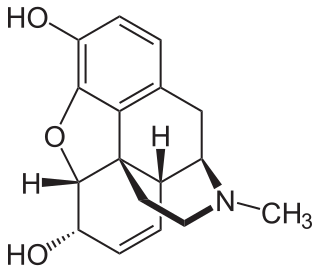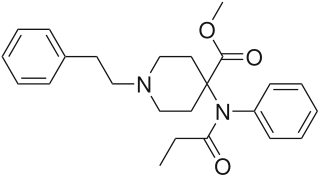Related Research Articles

Oxycodone, sold under various brand names such as Roxicodone and OxyContin, is a semi-synthetic opioid used medically for treatment of moderate to severe pain. It is highly addictive and is a commonly abused drug. It is usually taken by mouth, and is available in immediate-release and controlled-release formulations. Onset of pain relief typically begins within fifteen minutes and lasts for up to six hours with the immediate-release formulation. In the United Kingdom, it is available by injection. Combination products are also available with paracetamol (acetaminophen), ibuprofen, naloxone, naltrexone, and aspirin.

Fentanyl is a highly potent synthetic piperidine opioid primarily used as an analgesic. It is 20 to 40 times more potent than heroin and 100 times more potent than morphine; its primary clinical utility is in pain management for cancer patients and those recovering from painful surgeries. Fentanyl is also used as a sedative. Depending on the method of delivery, fentanyl can be very fast acting and ingesting a relatively small quantity can cause overdose. Fentanyl works by activating μ-opioid receptors. Fentanyl is sold under the brand names Actiq, Duragesic and Sublimaze, among others.

Tramadol, sold under the brand name Ultram among others, is an opioid pain medication and a serotonin–norepinephrine reuptake inhibitor (SNRI) used to treat moderately severe pain. When taken by mouth in an immediate-release formulation, the onset of pain relief usually begins within an hour. It is also available by injection. It is available in combination with paracetamol (acetaminophen).

Opioids are a class of drugs that derive from, or mimic, natural substances found in the opium poppy plant. Opioids work in the brain to produce a variety of effects, including pain relief. As a class of substances, they act on opioid receptors to produce morphine-like effects.

Carfentanil or carfentanyl, sold under the brand name Wildnil, is an extremely potent opioid analgesic used in veterinary medicine to anesthetize large animals such as elephants and rhinoceroses. It is typically administered in this context by tranquilizer dart. Carfentanil has also been used in humans to image opioid receptors. It has additionally been used as a recreational drug, typically by injection, insufflation, or inhalation. Deaths have been reported in association with carfentanil.
The Public Health Agency of Canada is an agency of the Government of Canada that is responsible for public health, emergency preparedness and response, and infectious and chronic disease control and prevention.

Christopher David Naylor, is a Canadian physician, medical researcher and former president of the University of Toronto. He is ICES scientist emeritus and founding CEO. In 2016, he was inducted into the Canadian Medical Hall of Fame.

Sunnybrook Health Sciences Centre (SHSC), commonly known as Sunnybrook Hospital or simply Sunnybrook, is an academic health science centre located in Toronto, Ontario, Canada. It is the largest trauma centre in Canada and the only accredited Level 1 trauma centre outside of the US. Sunnybrook is a teaching hospital fully affiliated with the University of Toronto. The hospital is home to Canada's largest veterans centre, in the Kilgour Wing and the George Hees, which cares for World War II and Korean War veterans.

Tapentadol, brand names Nucynta among others, is a centrally acting opioid analgesic of the benzenoid class with a dual mode of action as an agonist of the μ-opioid receptor and as a norepinephrine reuptake inhibitor (NRI). Analgesia occurs within 32 minutes of oral administration, and lasts for 4–6 hours.
"Pain ladder", or analgesic ladder, was created by the World Health Organization (WHO) as a guideline for the use of drugs in the management of pain. Originally published in 1986 for the management of cancer pain, it is now widely used by medical professionals for the management of all types of pain.
Ray Fletcher Farquharson was a Canadian medical doctor, university professor, and medical researcher. Born in Claude, Ontario, he attended and taught at the University of Toronto for most of his life, and was trained and employed at Toronto General Hospital. With co-researcher Arthur Squires, Farquharson was responsible for the discovery of the Farquharson phenomenon, an important principle of endocrinology, which is that administering external hormones suppresses the natural production of that hormone.

Thomas Edward Radecki is an American former psychiatrist, founding member of the National Coalition on Television Violence, and convicted criminal. He is known for his controversial views on the effects of portrayals of violence on teens and his opposition to depictions of violence in any form. He was later convicted of abusing his position as a doctor to commit sexual offenses; he was accused of trading prescription of opioids in exchange for sex with female patients. He is serving an 11- to 22-year prison sentence.
Perry Kendall, is a Canadian Public health physician who was Provincial Health Officer (PHO) for the Canadian province of British Columbia's health ministry from 1999-2018 and was awarded the Order of British Columbia for contributions to Public health field and to harm reduction policy and practice.
ICES is an independent, non-profit corporation that applies the study of health informatics for health services research and population-wide health outcomes research in Ontario, Canada, using data collected through the routine administration of Ontario's system of publicly funded health care.

There is an ongoing opioid epidemic in the United States, originating out of both medical prescriptions and illegal sources. The epidemic began in the United States in the late 1990s, according to the Centers for Disease Control and Prevention (CDC), when opioids were increasingly prescribed for pain management, resulting in a rise in overall opioid use throughout subsequent years.
"Addiction Rare in Patients Treated with Narcotics" is the title of a letter to the editor written by Jane Porter and Hershel Jick and published in the January 10, 1980, issue of The New England Journal of Medicine. The letter analyzed data on patients who had been treated with opioids in a hospital setting, and concluded that addiction was uncommon among such patients. It has since been frequently misrepresented to claim that opioids are not addictive when prescribed for use at home. This misrepresentation has been blamed for contributing to the opioid epidemic in the United States.

The opioid epidemic, also referred to as the opioid crisis, is the rapid increase in the overuse, misuse/abuse, and overdose deaths attributed either in part or in whole to the class of drugs called opiates/opioids since the 1990s. It includes the significant medical, social, psychological, demographic and economic consequences of the medical, non-medical, and recreational abuse of these medications.
Homer Chin-nan Tien is a Canadian trauma surgeon and the president and CEO of Ornge, an air ambulance non-profit based on Ontario. He also holds the rank of colonel in the Canadian Forces Health Services, associate professorship at the University of Toronto, and was the former director of Trauma Services at Sunnybrook's Tory Regional Trauma Centre. He is the first to hold the Canadian Forces Major Sir Frederick Banting Term Chair in Military Trauma Research.

Scott E. Hadland is a Canadian-American physician and scientist who serves as a pediatrician, and addiction specialist at Massachusetts General Hospital and Harvard Medical School, where he is the Chief of the Division of Adolescent and Young Adult Medicine. He previously served as an addiction specialist at the Grayken Center for Addiction at Boston Medical Center.
This timeline includes entries on the spread of COVID-19 misinformation and conspiracy theories related to the COVID-19 pandemic in Canada. This includes investigations into the origin of COVID-19, and the prevention and treatment of COVID-19 which is caused by the virus SARS-CoV-2. Social media apps and platforms, including Facebook, TikTok, Telegram, and YouTube, have contributed to the spread of misinformation. The Canadian Anti-Hate Network (CAHN) reported that conspiracy theories related to COVID-19 began on "day one". CAHN reported on March 16, 2020, that far-right groups in Canada were taking advantage of the climate of anxiety and fear surrounding COVID, to recycle variations of conspiracies from the 1990s, that people had shared over shortwave radio. COVID-19 disinformation is intentional and seeks to create uncertainty and confusion. But most of the misinformation is shared online unintentionally by enthusiastic participants who are politically active.
References
- ↑ "David Juurlink" . Retrieved 26 October 2020.
- ↑ "Meet the Expert Video Series featuring ICES senior scientist Dr. David Juurlink". YouTube. June 2, 2015. Retrieved 29 November 2022.
- ↑ "We are Sunnybrook". The Globe and Mail. 7 May 2011. Retrieved 24 June 2017.
- ↑ Kirkup, Kristy (26 February 2017). "Health Canada's position on opioid Tramadol is indefensible: doctor". The Globe and Mail. Retrieved 24 June 2017.
- ↑ Kirkey, Sharon (7 April 2016). "Doctors' reckless prescribing of fentanyl largely to blame for deadly overdoses: expert". National Post. Retrieved 24 June 2017.
- ↑ "Dr. David Juurlink says colleagues must accept blame for fentanyl ODs". CBC News. 24 August 2015. Retrieved 24 June 2017.
- ↑ "Opioid crisis: The letter that started it all". BBC News. 3 June 2017. Retrieved 24 June 2017.